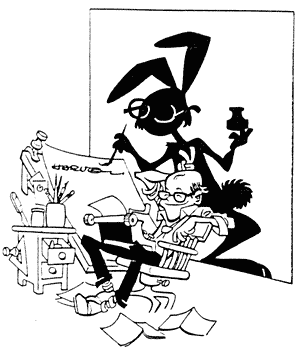Anyone wanting to know more about the history and art
of the newspaper comic strip might
consider might consider picking up a copy of The Art of the Funnies,
R. C. Harvey's aesthetic
history of the medium. Published in the summer of 1994, it went to a second
printing in
January, 1995. The first to celebrate the centennial of the American newspaper
comic strip, the
book was virtually sold out before the centennial year dawned.
Harvey, who produces an array of columns about comics in such publications
as The
Comics Journal, Comics Buyer's Guide, and at Overstreet's Fan Universe
website, has been
writing about comics for over twenty years in nearly ever major fan publication.
As a
cartoonist, he brings a knowing insight to his analysis of the medium.
Comics historian and scholar Ian Gordon, writing in Inks: Cartoon and
Comic Art
Studies, agrees: "The Art of the Funnies is probably the best
comic strip history currently
available."
Recommended for both academic and public libraries by The Library Journal,
the book
was acclaimed "a milestone" in Witty World, the international
journal about cartooning.
The first book's focus is entirely the comic strip, which was, by general
consenus, born in
1895 when Richard F. Outcault began producing the legendary Yellow
Kid series for the New
York World.
The comics have changed a great deal since Outcault's day, and Harvey
traces the ways
in which the medium developed and grew to maturity over the intervening
century.
Subtitled "An Aesthetic History," the book begins by examining
the way that words and
pictures function in telling stories and jokes. Harvey discusses the visual
elements that serve
this purpose--panel composition, narrative breakdown, and layout--as well
as the lives and
artistry of many of the country's greatest cartoonists.
"This is not a comprehensive history," Harvey said. "It's
an aesthetic history: it shows
how the comic strip developed. I've concentrated on those cartoonists
whose way of using the
medium shaped it."
In Mutt and Jeff, for instance, Bud Fisher showed how to deploy
the comic strip form in
daily installments. In Wash Tubbs, Roy Crane told adventure stories,
paving the way for Milton
Caniff with Terry and the Pirates.
In a chapter on Caniff, Harvey musters to his analytical task much information
he
unearthed while writing the biography of the cartoonist (like the "real
story" on how Pat Ryan
met Terry, for instance).
And in a chapter about illustrators' invasion of the comic strip, Harvey
analyzes the work
of Hal Foster and Alex Raymond, neither of whom were, strictly speaking,
cartoonists but both
of whom influenced how serious storytelling comic strips would be produced.
After discussing Sidney Smith's The Gumps, Harvey reviews the history
of comic strip
syndication, demonstrating how syndication stimulated the creative energies
of cartoonists,
resulting in the further growth and development of the medium.
In another chapter, the book examines the ways in which a man who was
not a cartoonist
at all--Joseph Patterson, publisher of the New York Daily News--influenced
the history and
development of the medium by coaching such pacesetters as Chester Gould
(with Dick Tracy),
Harold Gray (with Little Orphan Annie), and others.
Harvey also turns an affectionate eye to "works of genius"--comic
strips that did not
influence the medium because they were so individual and unique as to
be inimitable. Winsor
McCay's Little Nemo, for instance--and E. C. Segar's Thimble
Theatre ("Popeye"), George
Herriman's Krazy Kat, and Walt Kelly's Pogo.
"These were cartoonists whose achievement in the medium was monumental,"
Harvey
said. "Each of them plumbed the potential of the form, stretching
its storytelling capacity.
Although no one could ever imitate them, they showed that the medium was
capable of being Art
in the usual capitalized sense."
In the last chapter, Harvey shows how Charles Schulz with Peanuts set
the fashion for
gag strips--comic strips that told one joke a day--beginning in the 1950s.
He discusses the
decline of the storytelling (or "continuity") strip, elbowed
off the comics page by television and
by gag strips.
While Harvey laments the effect on the artform of shrinking size (it degrades
the visual
content of comics, making way for such aberrations as Cathy and
Dilbert), he also recognizes
recent developments (in such strips as Calvin and Hobbes and Non
Sequitur) that reaffirm the
visual-verbal blending that has distinguished comic strip art.
In the last analysis, he concludes, even badly drawn strips are individual
accomplishments and as such proclaim the validity of the artform as a
medium of self-
expression.
Harvey completed a second book on the subject two years later. Titled
The Art of the
Comic Book, it is almost a sequel to the first book, he says.
"I call it `Volume Two' of the aesthetic history," Harvey explained.
"It will show how the
comic book format grew out of the comic strip format but, being capable
of greater variety in
narrative methods, took the medium to greater heights than the comic strip
was capable of."
Like its predecessor, The Art of the Comic Book was a bestseller
and went into a second
printing before it had been out a year.
Order your copy here.

